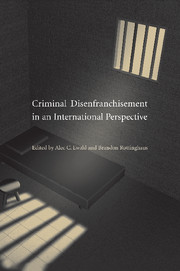Book contents
- Frontmatter
- Contents
- Contributors
- Foreword: Waves of Democracy and Criminal Disenfranchisement
- Acknowledgments
- Introduction
- Part I CONTEMPORARY DISENFRANCHISEMENT LAW
- Part II DISENFRANCHISEMENT IN COMPARATIVE PERSPECTIVE: LEGAL AND POLITICAL APPROACHES
- Part III VOTING RIGHTS AND PEOPLE WITH CRIMINAL CONVICTIONS: CASE STUDIES
- 6 The Politics and Legality of Prisoner Disenfranchisement in Australian Federal Elections
- 7 The Campaign for Prisoner Voting Rights in Ireland
- 8 The Ballot as a Bulwark: Prisoners' Right to Vote in South Africa
- 9 The Right to Vote in Danish Prisons
- 10 In Defense of Prisoner Disenfranchisement
- Index
- References
9 - The Right to Vote in Danish Prisons
Published online by Cambridge University Press: 03 July 2009
- Frontmatter
- Contents
- Contributors
- Foreword: Waves of Democracy and Criminal Disenfranchisement
- Acknowledgments
- Introduction
- Part I CONTEMPORARY DISENFRANCHISEMENT LAW
- Part II DISENFRANCHISEMENT IN COMPARATIVE PERSPECTIVE: LEGAL AND POLITICAL APPROACHES
- Part III VOTING RIGHTS AND PEOPLE WITH CRIMINAL CONVICTIONS: CASE STUDIES
- 6 The Politics and Legality of Prisoner Disenfranchisement in Australian Federal Elections
- 7 The Campaign for Prisoner Voting Rights in Ireland
- 8 The Ballot as a Bulwark: Prisoners' Right to Vote in South Africa
- 9 The Right to Vote in Danish Prisons
- 10 In Defense of Prisoner Disenfranchisement
- Index
- References
Summary
“A punishable offence shall not involve the suspension of civil rights, including the right to carry on business under an ordinary license or a maritime license.”
INTRODUCTION
These are the words of chapter 9, section 78, subsection 1 of the Danish Criminal Code, and this is where the story of prisoners' right to vote in Denmark begins. Prisoners have been allowed to vote in Denmark since the 1930s; before that time, the right to vote could be revoked for certain crimes. Denmark's policy is consistent with that of its Scandinavian neighbors – in Finland and Sweden, all prisoners retain the right to vote, whereas disenfranchisement in Norway is extremely rare – and Danish prisoners' right to vote seems secure. However, the Danish Constitution presently does not preclude the possibility of removing the right to vote for prisoners.
The goal of this chapter is to describe the rules and practices of voting in Danish prisons. In order to offer the reader an opportunity to imagine the context of the rules and practices in question, the first section briefly describes the prison system and some basic conviction statistics. The second section presents the legal basis of prisoners' voting, principally the Constitution and the Ministry of the Interior's Instruction on Postal Voting in Penal Institutions, published in 1970. Finally, the third section describes the practice of voting in Danish prisons, based on responses to a questionnaire distributed to Danish prisons by the author.
- Type
- Chapter
- Information
- Criminal Disenfranchisement in an International Perspective , pp. 244 - 258Publisher: Cambridge University PressPrint publication year: 2009
References
- 1
- Cited by

